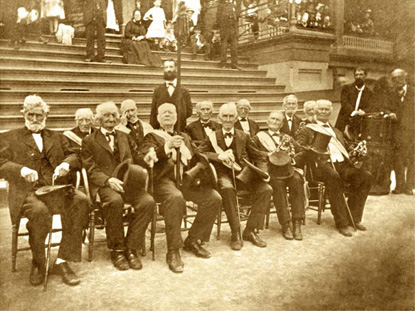Informal gatherings of veterans, organized locally, took place throughout the 1800s and kept memories of the War of 1812 alive.
In the postbellum United States, War of 1812 veterans acquired relict status, not so much because of the particular importance of the war itself, but simply because they were the oldest living American veterans.
Venerable Veterans

Maryland Historical Society
In New York City, for example, a group of ex-officers and soldiers formed a mixed Revolutionary War/War of 1812 veterans’ society after the peace of 1815, and as time passed, it was increasingly dominated by participants in the latter conflict. In 1826, the group established itself as the Military Society of 1812, and in 1848 it merged with a similar organization, the Veterans Corps of Artillery. The ranks of living 1812 veterans thinned substantially in the second half of the 1800s, and in 1890 the organization transformed its regulations to allow admission of hereditary members.
In Baltimore, 1812 memories were more fully cultivated. Here and in other places similarly visited and indelibly marked by the war (for example, Plattsburgh, New York, Cleveland, Ohio, or New Orleans, Louisiana), public memory endured, or at least faded less dramatically. As military crisis passed after 1815, particularly in towns, cities, and regions removed from the war’s theatre, the War of 1812 was barely remembered, except by those who had actually served. But not in Baltimore. The militia companies and regular troops that successfully repelled the British attack on the city in 1814 became known as the Baltimore “Defenders.” They gathered on the first anniversary of the defense on September 12, 1815, to celebrate the occasion and lay the cornerstone for the city’s Battle Monument. Thereafter, the commemoration became an annual event. In 1841, the Defenders established a more formal state organization, and in January of 1854, on the anniversary of the Battle of New Orleans (January 8), a national meeting of veterans at Independence Hall in Philadelphia took the first steps in establishing a larger umbrella organization. Subsequent gatherings consolidated various state groups into the General Society of the War of 1812, which persists and currently includes some 30 state associations.
Testament to a Melting Pot
In the postbellum United States, War of 1812 veterans acquired relict status, not so much because of the particular importance of the war itself, but simply because they were the oldest living American veterans. Late-1800s newspapers reported their passing, particularly as fewer and fewer remained. These ancient veterans connected Americans with a remote past, nearly to the days of the American Revolution, a time untainted by the bitterness and devastation of the recent Civil War. They offered the safety of nostalgia and symbolized a generalized American patriotism.
The oldest living veteran, Hiram Cronk, succumbed at age 105 in May 1905 at his home in upstate New York. He had played a minor role in the war, serving at Sackets Harbor. His daughter explained, almost apologetically, “There were a few skirmishes, but I guess the fighting wasn’t what they would call severe. Still he was there as a soldier, and he stayed there till the war was over.” Cronk’s primary accomplishment—perhaps like the United States in the war itself—was simple survival. Yet despite his humble part, Cronk’s longevity and the country’s patriotic desires earned him a state funeral, attended by thousands in New York and Brooklyn.
The impressive public memorializing of Private Cronk exemplified the democratization of American public memory, which began early in the 1800s and grew in the aftermath of the Civil War, as Americans struggled to assimilate its unprecedented losses. If Cronk was emblematic of an American Everyman, however, the hereditary organizations that emerged in the 1890s, some of which elevated descendants of the War of 1812 in particular, were elitist, not plebian. The United States Daughters of 1812 and the General Society of the War of 1812 took their place alongside the more famous Mayflower Society, the Sons and the Daughters of the American Revolution, and others, which admitted members based on blood descent and thus excluded most Americans—pointedly, recent immigrants from southern and central Europe.
Actually, a diverse array of Americans could claim the honor of service to their country in the War of 1812. Irish Americans were prominent in their participation, for example, even before the great waves of immigration following the Irish Potato Famine, and American Indians served distinctively and proudly as well, among them the famed Seneca orator Red Jacket and the prominent Pequot activist and author William Apess. Occasionally, the public confronted the fact that not all of the war’s veterans were white, as in January 1896 when a New York Times headline reported the death of Peter Peterson, an African American: “A Negro Centenarian Dead; Peterson Left His Master to Fight in the War of 1812.” Peter Peterson had been born a slave in 1795 and lived in bondage in Florida and Alabama before becoming a drummer boy in the War of 1812 and later a soldier in the Mexican War. Slavery endured in the United States until the Civil War, but for Peter Peterson, unlike most African Americans, it came to an end in the War of 1812.
Part of a series of articles titled Legacies: The War of 1812 in American Memory .
Last updated: April 2, 2015
